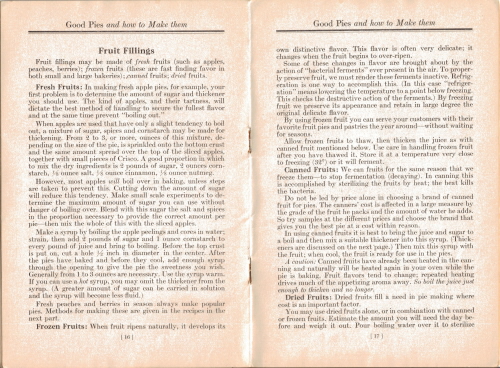 Here are pages 16 and 17 of the vintage recipe booklet “Good Pies & How To Make Them” that was published in 1928 by Crisco.
Here are pages 16 and 17 of the vintage recipe booklet “Good Pies & How To Make Them” that was published in 1928 by Crisco.
To review all pages in this booklet, simply visit the Crisco: Good Pies & How To Make Them Category and click on a page title to review that section.
There are scans available of each page, just click the images to view a full size copy.
Fruit Fillings
Fruit fillings may be made of fresh fruits (such as apples, peaches, berries); frozen fruits (these are fast finding favor in both small and large bakeries); canned fruits; dried fruits.
Fresh Fruits: In making fresh apple pies, for example, your first problem is to determine the amount of sugar and thickener you should use. The kind of apples, and their tartness, will dictate the best method of handling to secure the fullest flavor and at the same time prevent “boiling out.”
When apples are used that have only a slight tendency to boil out, a mixture of sugar, spices and cornstarch may be made for thickening. From 2 to 3, or more, ounces of this mixture, depending on the size of the pie, is sprinkled onto the bottom crust and the same amount spread over the top of the sliced apples, together with small pieces of Crisco. A good proportion in which to mix the dry ingredients is 2 pounds of sugar, 2 ounces cornstarch, 1/8 ounce salt, 1/8 ounce cinnamon, 1/8 ounce nutmeg.
However, most apples will boil over in baking, unless steps are taken to prevent this. Cutting down the amount of sugar will reduce this tendency. Make small scale experiments to determine the maximum amount of sugar you can use without danger of boiling over. Blend with this sugar the salt and spices in the proportion necessary to provide the correct amount per pie–then mix the whole of this with the sliced apples.
Make a syrup by boiling the apple peelings and cores in water; strain, then add 2 pounds of sugar and 1 ounce cornstarch to every pound of juice and bring to boiling. Before the top crust is put on, cut a hole 1/2 inch in diameter in the center. After the pies have baked and before they cool, add enough syrup through the opening to give the pie the sweetness you wish. Generally from 1 to 3 ounces are necessary. Use the syrup warm. If you can use a hot syrup, you may omit the thickener from the syrup. (A greater amount of sugar can be carried in solution and the syrup will become less fluid.)
Fresh peaches and berries in season always make popular pies. Methods for making these are given in the recipes in the next part.
Frozen Fruits: When fruit ripens naturally, it develops its own distinctive flavor. This flavor is often very delicate; it changes when the fruit begins to over-ripen.
Some of these changes in flavor are brought about by the action of “bacterial ferments” ever present in the air. To properly preserve fruit, we must render these ferments inactive. Refrigeration is one way to accomplish this. (In this case “refrigeration” means lowering the temperature to a point below freezing. This checks the destructive action of the ferments.) By freezing fruit we preserve its appearance and retain in large degree the original delicate flavor.
By using frozen fruit you can serve your customers with their favorite fruit pies and pastries the year around–without waiting for seasons.
Allow frozen fruits to thaw, then thicken the juice as with canned fruit mentioned below. Use care in handling frozen fruit after you have thawed it. Store it at a temperature very close to freezing (32°) or it will ferment.
Canned Fruits: We can fruits for the same reason that we freeze them–to stop fermentation (decaying). In canning this is accomplished by sterilizing the fruits by heat; the heat kills the bacteria.
Do not be led by price alone in choosing a brand of canned fruit for pies. The canners’ cost is affected in a large measure by the grade of the fruit he packs and the amount of water he adds. So try samples at the different prices and choose the brand that gives you the best pie at a cost within reason.
In using canned fruits it is best to bring the juice and sugar to a boil and then mix a suitable thickener into this syrup. (Thickeners are discussed on the next page.) Then mix this syrup with the fruit; when cool, the fruit is ready for use in the pies.
A caution: Canned fruits have already been heated in the canning and naturally will be heated again in your oven while the pie is baking. Fruit flavors tend to change; repeated heating drives much of the appetizing aroma away. So boil the juice just enough to thicken and no longer.
Dried Fruits: Dried fruits fill a need in pie making where cost is an important factor.
You may use dried fruits alone, or in combination with canned or frozen fruits. Estimate the amount you will need the day before and weigh it out. Pour boiling water over it to sterilize it, then wash with cold water and allow to soak about 12 hours. Drain off any surplus water and to the remainder add sugar and thickener as in the case of canned fruit.
 More Recipes For You To Enjoy:
More Recipes For You To Enjoy:




